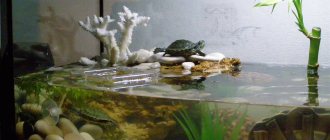The Achatina snail is one of the most famous and common pets, which has gained popularity due to its impressive size, easy care and exoticism. Despite the fact that every year there are more and more recommendations regarding keeping Achatina at home, many people have questions about how long Achatina snails live at home. Before you find out the life expectancy of these charming creatures, you should know that these numbers are influenced by many factors that the owner of the mollusk must be aware of.
Achatina in its natural environment
Achatina snails are a popular type of mollusk that is often kept as pets. In their natural environment, Achatina lives on tree trunks, slowly crawling along the bark and secreting mucus. These mollusks are unique in that they have long-term memory, and therefore are able to remember the owner and feeding places.
Achatina is active in the wild at night, feeding on buds, foliage and plants. The question of how long Achatina lives in the natural environment cannot be answered precisely: life expectancy is influenced by the environment, the number of enemies and parasites. According to rough estimates, in nature, mollusks can live up to 10 years, but in fact, many snails die much earlier. After all, outside the walls of the home tank, snails are warned of dangers: hunger, cold, predators and other deadly enemies.
Interesting fact: Achatina are the largest land mollusks. Some individuals can grow up to 35 cm in length and weigh about 2 kg. They are also considered the smartest of the gastropods.
The snail that conquered the world
Author Anton Evseev
16.09.2018 21:09
Zoosphere » Interesting
You won't meet anyone among pet lovers. Some people like tarantula spiders that look scary but are kind inside, others find pleasure in communicating with a variety of birds, and others cannot imagine their life without a medium-sized crocodile that lives in the bathroom. However, I personally have always been struck by one interesting pattern - for some reason, among pets, quite dangerous animals are most often found (even cute and friendly guinea pigs can cause serious injury with their teeth, let alone cats, dogs or parrots).
And only, perhaps, one of the pets is not at all capable of causing any harm to its owner, even if it tries very hard to do so. We are talking about representatives of a group of gastropods, simply called snails, among which the African land snail Achatina stands out for its size and intelligence.
However, in some countries, keeping (let alone breeding) these absolutely harmless creatures is strictly prohibited. For example, those who dare to do this in the United States can go to prison for 5 years, and their pets will be immediately destroyed. Similar bans apply in some countries in Southeast Asia.
Why did the giant snail fall into such disfavor? To answer this question, let’s talk about what kind of animals they are and how the widespread “Ahatinomania” began all over the world.
Lifespan of Achatina in home terrariums
Achatina are considered unpretentious creatures, which makes them popular and sought-after pets. Considering the unpretentiousness of mollusks, keeping Achatina is a pleasure, and every year people are becoming more and more interested in these charming creatures. Therefore, it is not surprising that before purchasing, future owners wonder how long Achatina lives at home.
Fortunately, with proper care and maintenance, these mollusks can live for a significant period of time - up to 10 years, delighting the owner, however, often inexperienced owners make a number of mistakes that affect how long Achatina lives. For example, you should not force your pet away from the glass, or squeeze the shell too hard - this can harm the shellfish, and the pet will become seriously ill. In order for your pet to be healthy, active and live a long time, you should know the factors that can reduce the lifespan of gastropods.
What do Achatina snails eat?
The main food for Achatina snails is plant food. Food for Achatina in the home environment should be varied. Mollusks eat a lot, so the list of what you can feed Achatina gastropods is wide. Most of all they love apples, fresh cucumbers, and lettuce, but Achatina’s diet should not be limited to these foods. Juveniles should be fed once a day. Feeding older Achatina snails should occur no more than 2 times a week. She eats mainly in the evening, since snails are nocturnal. Summer food does not differ from the winter diet, but in summer they can be fed with seasonal berries and fruits.
The main list of what to feed snails:
- tomatoes;
- legumes;
- mushrooms;
- boiled eggs;
- spinach;
- zucchini;
- boiled potatoes;
- sour cream.
If it has a calcium deficiency, the snail can feed on pieces of the shell, attacking its relatives. In such a situation, you need to add to the snail’s diet: sepia, crushed shell rock, shrimp called daphnia, and gammarus crustaceans. There should always be fresh water in the container. After eating, the remaining food must be removed so that it does not cause discomfort for Achatina.
What affects life expectancy in captivity
The two key factors that influence how long Achatina lives in terrariums are the living conditions and feeding diet. If the owner follows the recommendations and rules for caring for these giant mollusks, then there is nothing to worry about - Achatina will delight its owner for a long time. But in order to provide snails with decent conditions, you need to know about those factors that have a positive effect on the lifespan of pets.
Content
Decent maintenance is the main factor ensuring long-term life for snails. In order for the mollusk to live as long as possible, it is necessary to pay attention to the following points:
- Buy the right terrarium - the capacity of the house for one clam should be at least 10 liters, for two wards - at least 20 liters, and must be equipped with a lid. In cramped and small containers, snails will not be able to develop normally and may become ill.
- Choosing the right soil - this also determines how long Achatina lives at home. The soil for snails should be loose, without sharp edges, so that Achatina does not damage the delicate body and can easily burrow into the substrate. The thickness of the soil layer is 5-10 cm.
- Regularly moisten the substrate - for full development and growth, mollusks require a moist environment, so if the soil is dry, the snail will constantly hide in its shell. However, you shouldn’t be zealous either - if the soil is too wet, the mollusk will move to the walls of the container.
- Maintain a temperature of 25-28C - if the temperature deviates, Achatina hibernates.
- Systematically cleaning the terrarium from dirt - garbage and unsanitary conditions have never benefited anyone, so once every seven days you need to clean your pet's house. This cleaning should include wiping the walls, removing food debris and dirt. Once a year, a general cleaning is carried out and the soil is renewed.
Fun fact: Clams can crawl across a razor blade without getting hurt. This is due to the fact that the sole of gastropods secretes mucin, a substance that protects against wounds.
How to set up a terrarium for Achatina
To make snails feel comfortable and free, it is important to choose and arrange their housing correctly. Special soil is poured into the terrarium and a small pool is installed for bathing the snails. It is also important to monitor the humidity and temperature conditions in the terrarium.
Choosing a terrarium
In order for the snail to feel free, it is recommended to purchase it a home at the rate of ten liters per individual. After all, the larger the house, the larger the clam will grow. It is recommended to buy a twenty-liter terrarium with a lid for a family of mollusks.
Soil selection
The soil should be soft and loose, because the mollusks will burrow in it. The soil is poured in a layer of five or ten centimeters. You cannot use soil for plants, which is sold in many stores. The pet store sells coconut substrate in briquettes. It is poured with boiling water and cooled, and then placed in a terrarium. Instead, high-moor peat is often used.
How often to change the soil
The terrarium is cleaned once a week, the glass is wiped daily without using detergents. The soil must be changed once a year.
Maintaining optimal humidity
It is recommended to regularly moisten the soil, since snails often burrow into it. If the soil is very wet, the snail will sit on the wall of the terrarium for a long time. If it is very dry, the mollusk hides in the shell.
The temperature in the terrarium should be from twenty-five to twenty-eight degrees Celsius. If it does not comply with this, the snail will hibernate. An incandescent lamp can become a source of heat and light; there is no need to buy special equipment.
Diet
The food that is fed to domestic shellfish can significantly affect how many years Achatina snails will live. With improper nutrition, the chances of a healthy and long life for Achatina are much reduced, so every owner should know how to properly organize a diet for a pet.
The shellfish menu should include natural and healthy products: mushrooms, corn, boiled eggs, fresh vegetables and fruits. They should be given alternately so that the snails do not get used to any one product. Shellfish also need calcium, which is found in chalk or crushed eggshells. Pet stores sell special foods that are a source of vitamins and minerals.
You should not feed Achatina with fried, sour, spicy or salty foods - this will not lead to anything good, and certainly will not contribute to a long and healthy life for your pets.
Interesting fact: salt and sugar are two products that can instantly destroy Achatina.
Huge Achatina snails, despite their impressive size, remain cute and charming pets that more and more people around the world are happy to have. However, before buying a mollusk, you should carefully study the features of the care and maintenance of Achatina so that the pet pleases its owner for a long time.
Who is Achatina
These are representatives of the family of land gastropods, belonging to the subclass of pulmonate snails. Achatina has a shell and a body consisting of a head and legs. Compared to other snails, Achatina are real giants - the size of some individuals reaches 18-20 cm, and at the same time they weigh at least 500 g.
But these are not their only advantages - Achatina have a fairly developed intellect, they are smart and intelligent. Some owners manage to develop a number of conditioned reflexes in their pets. Snails get used to the owner, they recognize him and are able to distinguish him from other people.
The Achatina family consists of hundreds of species, representatives of which live in African countries, on the islands of Sao Tome and Madagascar. Thanks to human activity, at the end of the 19th century. appeared and successfully adapted in tropical and subtropical lands. In their natural environment they live in large colonies.











